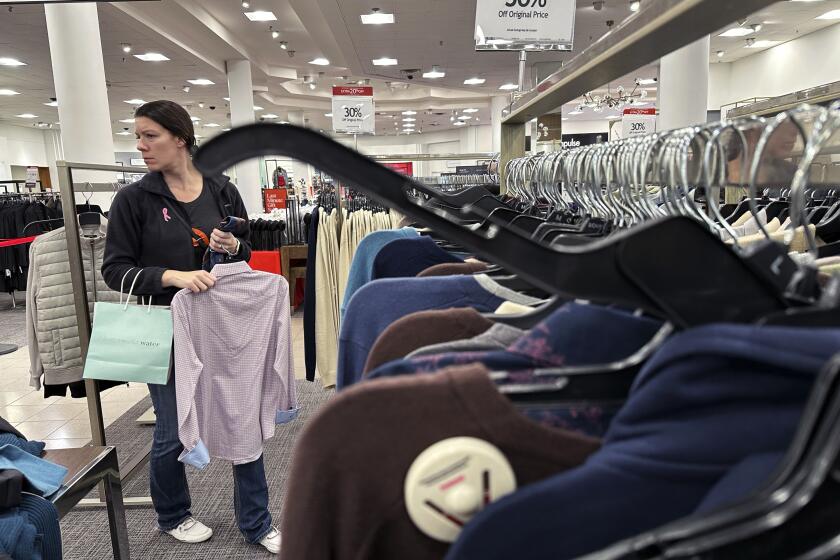SOUTHERN CALIFORNIA JOB MARKET : WEATHERING THE WORKPLACE : REDESIGNING WORK STATIONS
Desiree VanderVergt , a directory assistance operator with U S West Inc., dreaded her drive home. After seven hours of punching up telephone numbers on a computer keyboard, both her arms ached, especially her right one.
She’d climb into her car and drive, but it wasn’t pleasant. “I could shift, but it hurt,” she remembers, and because of her aches once she got home, “I didn’t want to do anything.”
U S West has from 400 to 500 operators working in two Denver offices and VanderVergt was but one of 144 employees, mostly operators, who complained of suffering everything from hand, arm and wrist aches on the job. U S West hired consultants and spent more than $1 million on new furniture and equipment.
Now each operator has an adjustable desk that cranks up or down--some operators like to work standing up--and each operator has a fully adjustable chair, while the new computer keyboards come with a lighter touch and can tilt, and a wrist rest is also standard equipment. All in the hopes of easing the strain on the hands, arms and shoulders. There are also footrests, partitions with sound proofing and indirect lighting to cut down on the glare off computer screens.
The prescription seems to work. Since early last year when the new equipment was put in, the number of complaints has dropped to 38, and all but one of those workers had also put in time on the old computer setup. U S West says it’s planning to changeover some other offices as well.
But the operators’ union, the Communications Workers of America, claims much of the credit for the improved work conditions. Jack Hawkins, vice president of local 7777 in Denver, said it was only after his union filed complaints with the Occupational Safety and Health Administration that U S West acted. This “prodding,” Hawkins says, is what made the difference. “It’s my understanding that the widespread problems have been resolved,” he said.
As for VanderVergt, after some physical therapy and a split work shift, she’s feeling better. “There are times I notice the pain in my arms, but I don’t think it’ll affect me for the rest of my life,” she said.
U S West’s expensive lesson is being repeated across the country. A personal computer, desk and chair--or to use the jargon--your work station, can be your worst enemy. Consultants figure the surge in computer-related jobs, up to 20 million and rising, is a big reason why. Computer keyboards, after all, work faster than any typewriter, but the high-speed also cuts down on the pauses that a worker used to take to, say, to change a sheet of paper. A combination of poor office furniture, more computers and long hours in awkward positions adds up to a royal pain in the neck for American industry.
The National Institute for Occupational Safety and Health estimates that 5 million Americans a year suffer from motion injuries. Estimates for the annual loss in earnings and the cost of medical treatments to cope with all the motion injuries have ranged as high as $27 billion, and today about 30% of all worker’s compensation claims are for soft-tissue problems. That includes various back problems and the dreaded carpal tunnel syndrome, where the tendons in the wrist swell from constant bending and squeeze the median nerve that leads to the fingers. Carpal tunnel syndrome can cause tingling, numbness in hands and arms, and searing pain; in severe cases surgery is the only alternative.
Of course, some will read this and think: what, me worry? Thomas Reed, who runs Valley Physical Therapy & Sports Medicine in Van Nuys and has treated all manner of white collar walking wounded, advises even if you feel fine today at work, be careful. “The body has this tremendous ability to adapt to all these wrong things we ask it to do. Eventually the tissues are no longer able to adapt and they begin to break down.” He dubs this “the Fernando syndrome,” after Dodgers pitcher Fernando Valenzuela, who after seven workhorse campaigns last season came down with a shoulder injury.
The same accumulated wear and tear can happen with office workers. If you keep moving in the same direction too often, Reed says, constant irritation of the tendons, muscles and connective tissues cause fluid and scar tissue to build up “and the free gliding motion that is necessary for ease of motion goes away.”
To an experienced eye, a “bad” work station is as evident as the Hollywood sign. Mark Sanders, an ergonomics consultant at California State University, Northridge says he often spots “very high desks designed for writing, and they’ve stacked computer terminals on top. The CPU unit (computer screen) is way up in space.” That forces somebody to constantly look up at their computer screen which could easily cause neck or shoulder injuries. Studies have shown the ideal posture is to look relatively straight ahead with your eyes slightly above the top of your computer screen. Operator VanderVergt complained that her keyboard was three inches off her desk and without a wrist rest she was typing with her wrist bent upward, while the ideal, “neutral” wrist posture is with the hand and wrist roughly straight.
Another bad sign is if the computer screen or keyboard is off to the side of your desk and you can’t sit squarely in front of the screen. This twisting posture can be a problem, says Dr. Robert Chandler, a surgeon at the Kerlan-Jobe Orthopaedic Clinic in Inglewood. Even the little things are worrisome. Chandler winces when he spots somebody who is on the phone all the day “and you see them using a telephone instead of a headset. That’s an obvious problem. Craning the neck over to the side to trap a phone” can cause neck injuries.
Of all the possible design hazards at work, one of the most obvious is uniform furniture. Look about your office. You might see someone tall enough to play for the Lakers or short enough to ride in the Kentucky Derby, yet both may be asked to use the same type of chair and desk. Flexibility, with adjustable chairs (see accompanying article) and adjustable desks can go a long way toward easing workers’ aches and pains, said Grahame Watson, a furniture designer. “It stands to reason that being able to adjust into the most extreme sort of work positions means you can accommodate an assorted bunch of people and increase productivity,” he says.
U S West reached much the same conclusion, and now many office furniture companies sell adjustable desks including Westinghouse, Steelcase, and the company Watson runs near Seattle called Watson Furniture Systems. Watson sells what he calls a Flex-Station (about $800), a sophisticated adjustable computer desk that has two surfaces, one for the keyboard that slides in and out 5 inches, enabling somebody to type up close or leaning back in their chair, while the keyboard adjusts from 25 to 40 inches off the ground and also tilts up to 11 degrees. Meanwhile, the platform for the computer screen also adjusts widely.
Watson’s customers include McGraw-Hill, Travelers Insurance and police departments where an adjustable work area comes in handy because some shifts are on duty 24 hours a day. He also sells a more modestly priced articulated arm ($145) to hold a personal computer keyboard that can also move in, out, up and down.
No matter how sophisticated the furniture, though, it’s important to stay flexible yourself. “Every 30 to 45 minutes you ought to get up and walk for 5 minutes,” says Dr. William Dillin, a spine surgeon at Kerlan-Jobe. It helps release the accumulated stress in the muscles and spine.
Alas, not every company is about to make wholesale changes in office furniture. “It gets expensive. For many companies it’s a big deal just to bring in computers. Now to suddenly go around and put lots of money into desks and chairs isn’t a small proposition,” says CSUN’s Sanders. So it’s worth considering some do-it-yourself, cheapie, preventative measures.
Computer screen too low? Use a telephone book underneath to prop it up. If there’s no footrest issued by the company, “Use a telephone book or a box,” Sanders said. Other consultants suggest exercising your eyes after close-in work by periodically focusing on something in the distance. If the lighting is bad, “make a hood out of cardboard,” Sanders said, to cut the glare on the computer screen. “Document holders to prop up papers to the same level as your eyes,” he says, are another good idea to help avoid bending over while you type. He also urges reorganizing your desk to eliminate unnecessary stretching by putting rarely used items at the periphery of your desk.
A final Sanders tip: “Clear up space under your desk. Very often people sit with the barest minimum space and pile things under their desk. It locks you into one position.”
More to Read
Inside the business of entertainment
The Wide Shot brings you news, analysis and insights on everything from streaming wars to production — and what it all means for the future.
You may occasionally receive promotional content from the Los Angeles Times.







